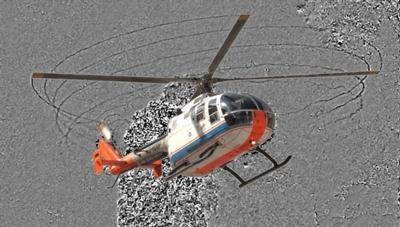Wed, Jan 08, 2014
Rotor Vortices Seen And Measured During Experiments
Researchers from the German Aerospace Center (Deutsches Zentrum fuer Luft- und Raumfahrt; DLR) based at Goettingen and Braunschweig have succeeded for the first time in visualizing the main cause of what makes helicopters so noisy while in the air. To do this, they conducted at times daring in-flight experiments – most recently in a quarry in the Harz region. The knowledge they acquired will open up opportunities to make future helicopters much quieter.

Helicopters can perform vertical take-offs and landings thanks to their main rotor, but this is also the reason why they are so noisy in flight. "Almost everything heard from a helicopter is aerodynamic noise. A large proportion of that is caused by what are known as blade tip vortices," says Markus Raffel, Head of the Helicopter Department at DLR Goettingen. Blade tip vortices form at the outermost end of a rotor blade; a zone of reduced pressure forms above the blade and a region of increased pressure forms below the blade.
As the air flows around the blade tip to reduce the pressure difference, a concentrated vortex is created behind the blade tip. "The noise comes from the vortex behind a rotor blade interacting with the following rotor blade," explains Andre Bauknecht, leader of the current experiments. These vortices are not just responsible for the typically 'carpet beater' noise; they also produce vibration within the helicopter and make the ride less comfortable for passengers.
The researchers employed a well-known phenomenon to conduct their tests. On hot summer days, the air above some sections of a road starts to shimmer. This is due to fluctuations in the air density causing refraction of light, which is visible as striations when perceived against a suitable background. Raffel and his colleagues exploited this insight to develop what they call the Background Oriented Schlieren Method (BOS), a system now used in aerodynamic test facilities throughout the world.
Last year, the DLR scientists conducted a series of unique and at times daring experiments to test the new measurement method in flight. The Göttingen-based researchers employed a novel technique, using natural background areas to visualize the rotor vortices. "A suitable background must be as finely textured and uniform as possible – so we investigated where nature can offer this kind of surface," says Bauknecht.
During one test, a Swiss Air Force Cougar helicopter maneuvered in front of a rocky background in the Alps. For the first time, images of a helicopter in flight produced a sufficiently precise visualization of rotor blade vortices to enable the acquisition of scientific knowledge. During other tests, the DLR BO 105 research helicopter flew over fields and meadows near Salzgitter and Braunschweig, while researchers in a microlight aircraft flying above the helicopter acquired images.
The latest experiment took place just recently; the BO 105 descended into a quarry in the Harz region – a hazardous environment for a helicopter. The confined space and maneuvers so close to the ground tested the skill of the DLR test pilots. In places, they were asked to perform rocking maneuvers barely 30 feet above the ground while the loose scree littering the excavated rock face served as a backdrop. But the effort was rewarded; ten cameras set up at various angles yielded images of such quality that, for the very first time, a substantial proportion of an in-flight helicopter's rotor blade vortices could be visualized in three dimensions.
The next round of flight tests will involve fitting helicopters with measurement equipment, enabling a direct comparison between the vortices recorded and the control inputs from the pilot. It is already evident that the DLR measurement technology has the potential to become an important tool for industry. Altering the blade shape or modifying the rotor controls could enable a reduction in blade tip vortices and their interaction with the blades trailing behind. "This would help helicopter manufacturers to compare various rotor blades under realistic conditions and to select the quieter option," says Bauknecht. As a result, there will be new opportunities to make future helicopters quieter and more comfortable.
(Image provided by DLR)
More News
Touchdown Zone Lighting Two rows of transverse light bars located symmetrically about the runway centerline normally at 100 foot intervals. The basic system extends 3,000 feet alon>[...]
“Discovery and innovation are central to our mission at Virgin Galactic. We’re excited to build on our successful record of facilitating scientific experiments in subor>[...]
"We are reaching out to you today on behalf of the Popular Rotorcraft Association because we need your help. We are dangerously close to losing a critical resource that if lost, wi>[...]
UAS Traffic Management (UTM) The unmanned aircraft traffic management ecosystem that will allow multiple low altitude BVLOS operations and which is separate from, but complementary>[...]
Aero Linx: Society of Aviation and Flight Educators (SAFE) SAFE is a member-oriented organization of aviation educators fostering professionalism and excellence in aviation through>[...]
 ANN's Daily Aero-Term (05.02.24): Touchdown Zone Lighting
ANN's Daily Aero-Term (05.02.24): Touchdown Zone Lighting Aero-News: Quote of the Day (05.02.24)
Aero-News: Quote of the Day (05.02.24) Aero-News: Quote of the Day (05.03.24)
Aero-News: Quote of the Day (05.03.24) ANN's Daily Aero-Term (05.03.24): UAS Traffic Management (UTM)
ANN's Daily Aero-Term (05.03.24): UAS Traffic Management (UTM) ANN's Daily Aero-Linx (05.03.24)
ANN's Daily Aero-Linx (05.03.24)



